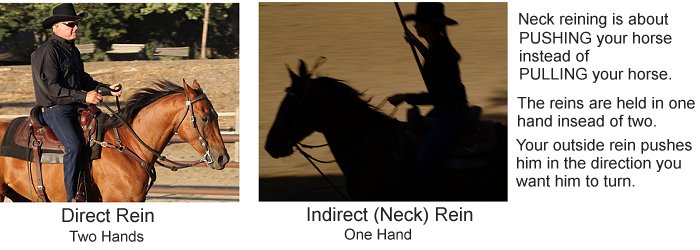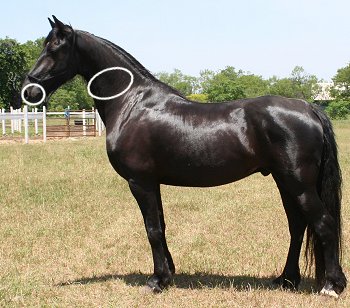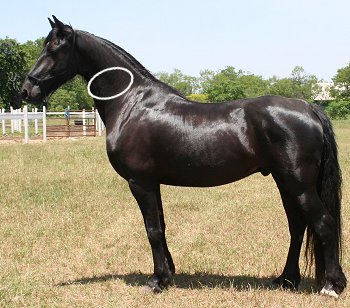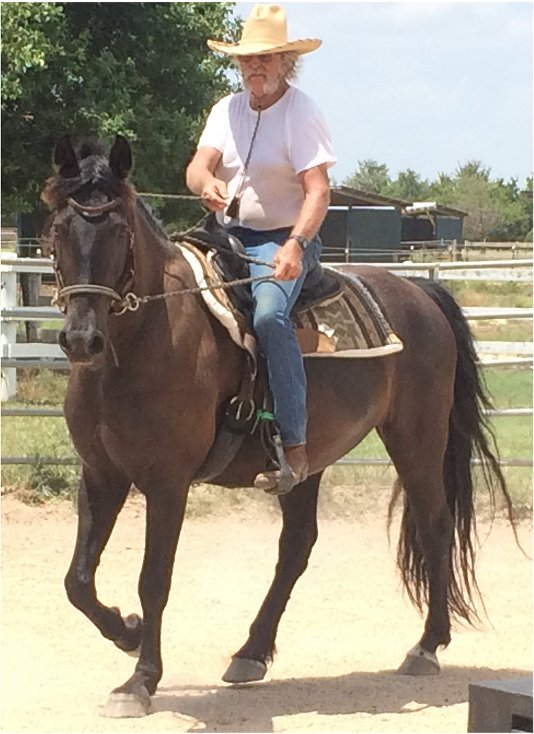 Neck Reining is the use of Indirect rein pressure. Both reins are held in one hand (usually your left hand). When the reins are laid across the horse’s neck on the left side, he is supposed to turn to the right (as if the rein is pushing his head right). When laid across the neck on the right he is supposed to turn left (away from the rein pressure). The horse is cued off of the “outside” aides: the outside rein pushes his neck in the direction you want him to go. Your outside leg pushes his body (shoulder) in the direction you want him to go. An outside neck tap with a whip pushes his shoulder over in the direction you want him to go.
Neck Reining is the use of Indirect rein pressure. Both reins are held in one hand (usually your left hand). When the reins are laid across the horse’s neck on the left side, he is supposed to turn to the right (as if the rein is pushing his head right). When laid across the neck on the right he is supposed to turn left (away from the rein pressure). The horse is cued off of the “outside” aides: the outside rein pushes his neck in the direction you want him to go. Your outside leg pushes his body (shoulder) in the direction you want him to go. An outside neck tap with a whip pushes his shoulder over in the direction you want him to go.
Cowboys developed the one-handed neck rein because they frequently needed one hand to control the horse and the other for the use of a lariat, a gun, or to tip their hat to a lady.



The transition from pulling his face around (direct reining) to guiding his neck over (neck reining) seems tricky. But it is harder to figure out for a human than for a horse. Either way, the horse is yielding to the pressure. With direct reining, the pressure is on his face on the opposite side from the expected turn. As he yields to the pressure on his face, he turns away from it and into the turn.
When you begin using indirect pressure, he moves into the turn because he is moving away from (yielding) the pressure on his neck. Either way, the pressure is on the side of his body opposite the turn, and he is yielding from the pressure into the turn. One pressure point is his mouth, the other is his neck.
The instruction here is presented for the weekend rider who wants a relaxing ride. For equitation or western pleasure show riding, it may not be precise enough.
 Teach on the Ground first
Teach on the Ground first
Your horse learned during his Yield the front quarters training how to move away from pressure in the forward 1/3 of his body. That training can come in handy here. While we don’t necessarily want him to spin on his haunches every time you lay the rein on his neck, we do want him to move away from that rein in a less dramatic manner. Sensitize him to that area of his neck to be sure that he is soft and supple to your request to move using that cue spot. Then proceed with the methods below.
Step 1: Mark out a nice square pattern in the arena to make some 90 degree turns.
Your body position is important. Sit upright in the saddle when walking a straight line, allowing your shoulders to turn VERY IMPERCEPTIBLY in the direction of your turn as you make the request.
Step 2:  Introduction: Using two hands, simultaneously lay the rein on the outside of your horse’s neck with one hand while pulling his face in the direction of the turn with the other.
Introduction: Using two hands, simultaneously lay the rein on the outside of your horse’s neck with one hand while pulling his face in the direction of the turn with the other.
In this case, you are using two aides simultaneously: pairing the old cue (direct rein) with the new cue (indirect rein): He is feeling the firm rein on the pushing side of his neck while he is experiencing the familiar pull of the direct rein.
Step 3: Teach: Begin to lag with the pulling rein. That is, lay the outside rein across his neck BEFORE you pull the direct rein, using the direct pull as a pressure that he would like to avoid.
Step 4: At the same time that you are using the reins, use your outside leg to push his shoulder around the corner. Be sure you have taken all pressure off of your inside leg so that he can move freely in the direction of your request. (You are also teaching leg cues while we are teaching this exercise, by the way. The leg aide is also a new cue being paired with the old direct-rein cue)
Step 5: Release. When he has made the turn, release the aides and let him walk a straight line. Give him a relaxing walk to “compute” what just happened and relax.
Soon, he will anticipate the turn from the outside rein and/or leg before the direct rein makes contact with his face. Refine a little more with even less use of the direct rein and more use of the leg aide.
Horse training can be dangerous. Not all methods work on all horses. Instruction presented here is not meant to be prescriptive in nature, and Horse-Pros.com takes no responsibility for the welfare of any animal or person using our methods.
We certainly don’t know everything. Please share your expertise and experiences. Comment on what is already written or Suggest a Category and Educate us about it. Grow Horse-Pros.com©